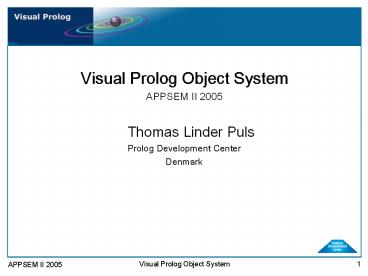Thomas Linder Puls - PowerPoint PPT Presentation
1 / 14
Title:
Thomas Linder Puls
Description:
AI system for shock absorber design (constraint resolution engine) Oersted satellite on-board software (Ada) Prolog Development Center. Staff Planning & Scheduling ... – PowerPoint PPT presentation
Number of Views:177
Avg rating:3.0/5.0
Title: Thomas Linder Puls
1
- Visual Prolog Object System
- APPSEM II 2005
- Thomas Linder Puls
- Prolog Development Center
- Denmark
2
Thomas Linder Puls
- Masters Compiling ?-prolog
- PhD Higher order logic (type theory)
- Computer Resources International
- AI system for shock absorber design (constraint
resolution engine) - Oersted satellite on-board software (Ada)
- Prolog Development Center
- Staff Planning Scheduling
- Visual Prolog (6 years)
3
Prolog Development Center
- Founded in 1985
- Prolog Compiler for MS-DOS (masters project)
- Copenhagen, Denmark (50 employees)
- Staff Planning Scheduling
- Aviation Planning Scheduling
- Production Planning Scheduling
- Hospital Booking
- Emergency Management
- Speech Recognition
- St. Petersburg, Russia (15 employees)
- Visual Prolog
- Agile Team Team/Project Management
4
Language Characteristics
- Logical programming language based on Prolog
- not ISO-Prolog compliant
- Successor of Turbo Prolog and PDC Prolog
- Compiled for Microsoft Windows (i386)
- Object-Oriented
- Non-determinism/backtracking
- Unification, pattern matching
- Algebraic data types
- Fact databases
- Functions
- Statically typed
- Multithreaded
- Garbage Collected
- Industrial Strenght
5
Object System
- Class based object system
- Separate
- Interfaces
- Class declarations
- Class implementations
- Support of multiple interfaces
- Multiple inheritance
- State is completely hidden
- Object callbacks (seamless C delegates)
6
Interfaces Object Types
- Interfaces define object types
- interface person predicates getName
() -gt string Name. setName (string
Name).end interface person - person is an object type
- All objects of the person type has predicates
getName and setName - person is not bound to any particular class any
class can support the person interface
7
Interface Support
- An interface can support other interfaces
(hierarchically) - The support hierarchy is a subtype/is a
hierarchy - interface user supports person predicates
getLoginName () -gt string Name.end
interface user - user is an object type
- user is subtype of person
- A user object can be used as a person object
(subsumption) - A user object has predicates getLoginName,
getName and setName - Multiple supports is supported
- Support does not imply any code inheritance
8
Class Declarations
- A class can construct objects of some object type
- A class does not define a type
- class userClass user constructors
newUser (string LoginName, string Name).end
class userClass - userClass is a class that constructs objects of
type user - userClass has a constructor named newUser
- To construct an object newUser is invoked as a
function - User userClassnewUser(thomas, Thomas
Puls),UsersetName(Thomas Linder Puls) - Class declarations are declarative (for the
programmer, not for the compiler) - Implementation details not mentioned
(inheritance, override, etc)
9
Implementation Inheritance
- A class must have an implementation
- implement userClass inherits personClass
facts loginName string. clauses
newUser(LoginName, Name) -
loginName LoginName,
personClassnewPerson(Name). clauses
getLoginName() loginName.end interface person - State is hidden in the implementation, and can
only be accessed there - Inheritance is hidden in the implementation
10
Specialities (1)
- Objects are completely abstract
- This is the only exception
- Objects can only be accesseed through their
interfaces - This also goes for objects of the same class
- classes do not define types
- This also goes for inherited objects
- seamless multiple inheritance
- Classes do not define object types
- Liberty to re-implement any object type
- No access modes (no protected, no friends, etc)
- Class declaration is separate from implementation
- Separate version control (declaration is a
contract) - More files for the same class
11
Specialities (2)
- Support (subtype) is separate from inheritance
- Conceptually clear
- Liberty to be something without being forced to
inherit anything - Inheritance is hidden/private
- Natural to hide information that has no
interest for users - Complicates implementation (compiler lacks
information) - State is hidden (non-optional)
- In line with best practice hide representation
- Sometimes to elaborate
- Information for programmer, not for compiler
12
Additional
- Object Callback (object in predicate closure)
- Pred UsersetName, Pred(W.A.M.)
- Invocation of Pred acts on the User object
- Delegate (dynamic inheritance)
- implement someClass delegate interface
person to currentPerson facts
currentPerson person. - The person interface is delegated to the
currentPerson fact variable - I.e., inherit person behavior from the
currentPerson object - The effective inheritance can be changed
dynamically
13
Future
- Generics (parametric polymorphism)
- List comprehension
- Structured language constructs (if-then-else,
foreach) - Name spaces
- Anonymous predicates (?-expressions)
- Properties
- F-bounded polymorphism
- Guarded monitors
- .net CLR (managed code)
14
More info
- Visual Prolog
- http//www.visual-prolog.com
- Discussion forum
- http//discuss.visual-prolog.com
- Prolog Development Center
- http//www.pdc.dk
- CD
- Visual Prolog 6.3 Personal Edition
- including Visual Prolog 7.0 alpha































